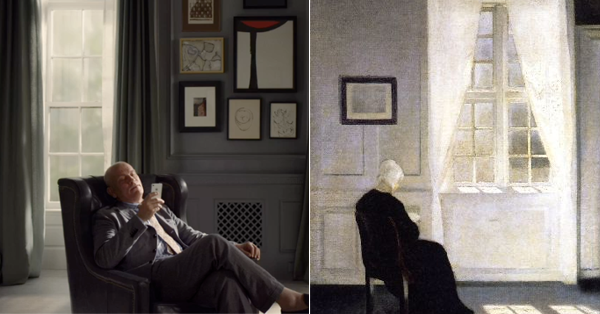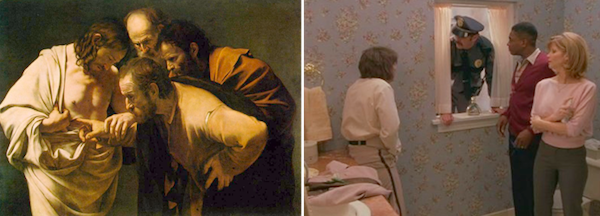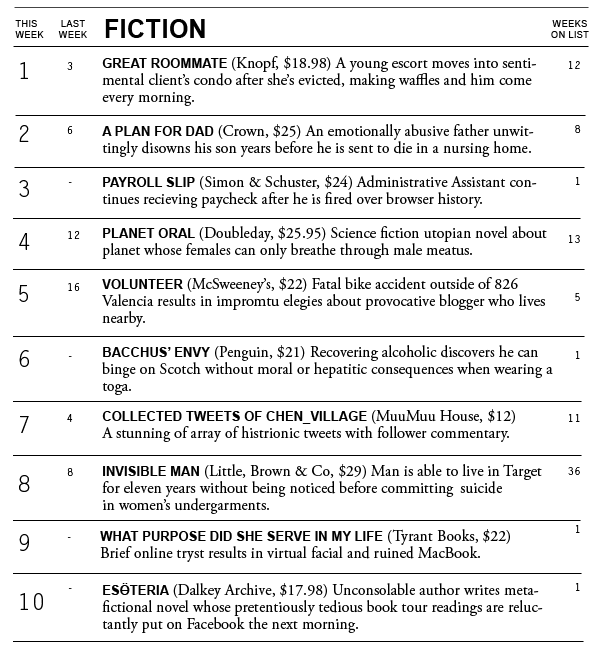Public Collection

Of a kind of modesty far disproportionate to the attention it’s getting — for it would take a hacker to get into our former president’s sister’s email — amateur yet keenly perceptive paintings by George W. Bush have surfaced. They are remarkable: not so much their rendering or skill, but in their quiet internal repose, evocative of the peculiarities of the Nabis post-impressionist school. An immediate, and easy association — if one considers their respective and mindless havoc onto their perceived enemies — is Adolf Hitler, who also produced unexpected touching watercolors of churches. The imperial hubris with which Bush demonized Afghanistan at large, and later Iraq, is a sad example of turning the enemy into an abstraction. The same can be said for liberal media in their inclines against Bush; and so now, it seems, we are perplexed, and very taken aback at being allowed to see this man in a different light. It is simply hard to imagine such a heartless war monger painting such gentle paintings. Yet, the disparity lies not with Bush’s character, but the assumption that artists are somehow — by the very auspices of their art, as if introverted pastime were a moral act — essentially good people. Enter Pierre Bonnard, whose codependent relationship with his wife Marthe has kind of hilariously been documented by the many paintings of the her in the bathtub. She is said to have suffered from OCD and compulsively bathed half-a-dozen times a day, as if trying to wash away the dabs of paint for which she might have been mistaken by her husband. The pairing here is at best merely coincidental, until we look at their perspectives: George W. Bush gives us his own POV, as autoerotic muse, his phallac member just off the bottom of the canvas, perhaps the rod-like stream of water a surrogate hard on. This is the same view Marthe was having back around 1935, and toggling between the two collapses us into a kind of he-said-she-said scenario, of different versions of the same history.
Dating Siri

With the release of Siri, an “intelligent personal assistant” app introduced in iOS6, Apple took a unique marketing approach, that of entitled idleness. We see John Malkovich, a cloud of constant irony around him, seated at home skeptically saying “life” into his phone. Siri then offers this advice: try and be nice to people; avoiding eating fat; read a good book every now and then, get some walking in, etc. (c.f. “Fitter Happier,” OK Computer). It’s as if the ad were making fun of the app, bowing to the absurdity of first world problems gone amuck, which is a peculiar move for Apple, whose ads are usually literal and almost condescendingly simplistic (e.g. dancing silhouettes, sincere FaceTime). The camera takes long pans of his house, giving into a kind of bourgeois, somewhat sad reverie: the tempting light of a good day yawning through the panes, the modern art hung salon style on the walls, a suit jacket flayed open to let the smallest gut out. There is even a faint air of derision. Vilhelm Hammershøi, a Danish late 19th century minor painter, made banal paintings in the then climate of fierce modernism; they were sentimental and weak-handed, simply not a match for the explosiveness of his more devastated peers. There’s a clear homage to Vermeer, and one may see him as a precursor Edward Hopper, but overall it’s rather forgettable. He painted his house from a dozen angles, repainting the same scene a year or so apart, his averted subjects slightly older, and having wandered elsewhere. The movement of light across the floor was more of an event, sans notifications and likes. People were walking sundials, the radius of their slow shadows boring as fuck. They knitted, read, and died early.
Some things about Mary

Caravaggio’s The Incredulity of Saint Thomas (c. 1602), known colloquially as “Doubting Thomas,” shows the titular Apostle incredulously putting said incredulity to rest upon sticking his finger inside Jesus’ wound after his resurrection (whose phonetic ties to “erection” may be our first mouthful of phallicy). Jesus says, “Blessed are those who have not yet seen and yet have believed,” a somewhat snarky comment directed at the proof contingency of Thomas. God, a prick in my book, denies the Virgin Mary any clitoral or vaginal stimulation, deferring to the “divine agency” of his bodiless baby batter. Anal seemed out of the question as well. Their son Jesus is likewise denied carnal knowledge with his own Mary (Magdelene), our codependent threesome the world’s first dysfunctional family. I’ve always found Jesus’ loin cloth a sunken concavity, almost tucked-in in trying perhaps to be a daughter. Emasculate comes from the latin emasculare, meaning castrate, fortunately used in a figurative sense. Ben Stiller’s comedic and dramatic qualms in Meet the Parents, Reality Bites, Greenberg, and There’s Something About Mary all tell the story of a dude’s trouble either getting or holding on to the girl. It’s bro humor, but not of sexual entitlement, rather, feminine-like worry and desire for love. Zoolander may even have a touch of peer misandry, and I find Stiller’s work “cutting edge” when it comes to chronic castration anxiety. Back in Rhode Island, in which most Farrelly brothers films are set, Mary’s mother and step-father, along with a doubting cop, cannot believe what Ted Stroehmann did to his “frank” and “beans” until they see it. Here the Farrelly brothers cut to the proof, in the unedited version at least.
Flags and Fists

On December 19 1984, Daniel Larusso defeated Cobra Kai α-male John “Johnny” Lawrence in the final match of the All Valley Karate Championships using the “Crane,” a kick derived from a Zen-like balance within, best practiced on a stump. One wonders if sweeping Daniel’s leg didn’t simply clear the floors to his enlightenment. The tournament’s logo, likely a creation of the film’s set designer, is a fist from the POV of an imminent victim. Turn it 90° on its side, and you have a quick allusion to a fist-pumping “wax on/wax off” Daniel likely practiced in his bed every night with quixotic visions of Ali (Elizabeth Shue). The film’s real muse, however, is transcendental absorption — to catch a fly in chopsticks not with one’s eyes, but knowing. All this faux-Buddhism, despite the slightly racist exoticism, is a wonderful thing. Daniel’s shower curtain costume on that fateful night may be a metaphor for evasion, conceived by Mr. Miyagi who himself had been hiding from troubles back in Okinawa. The red dot in the flag of Japan represents the sun, though its derivative in the flag of Bangladesh symbolizes the blood shed in gaining independence from Pakistan. “If a white flag means surrender, a black flag represents anarchy,” says Raymond Pettibon, co-founder and designer of Black Flag’s logo, which I always considered a fist with a tucked-in thumb. Unlike Karate, which employs offensive strikes, Jujutsu (literally, “the art of yielding”) is a grappling martial art in which an opponent’s force — both as vector and psychological intent — is used against himself. Daniel would have simply gotten out of the way, a John Cagean absence splattered by boos. As a flying fist gives you something to run from, anarchy may give a kid something to run to. I turn up “Rise Above” at work, but am only able to relate to …it’s no use, never mind the preceding try to stop us, but… A true cynic will not believe in punk (only what his hypochondria tells him). Henry Rollins staunchly stands on stage with taut legs hunched in some martial stance, as if bracing himself for the unknown. There is a moment of dread when a mosh pit begins to form around you. Someone hit my face and my glasses flew off. I got on my hands and knees, desperately grasping for re-vision, a halo of flailing arms above me and boots so near my fingers but never quite touching. It’s like I disappeared.
Movie Potpourri

I.
In “Encore,” (Book XX, Seminar, 1972) Jacques Lacan claims that St. Teresa is coming in Bernini’s Ecstasy of Saint Teresa (1652) — one may imagine his soft pink academic finger placed right on it — which seems post-whateverly reasonable after reading the subject’s autobiography, in which she states “I saw in his hand a long spear of gold, and at the iron’s point there seemed to be a little fire. He appeared to me to be thrusting it at times into my heart, and to pierce my very entrails; when he drew it out, he seemed to draw them out also, and to leave me all on fire with a great love of God. The pain was so great, that it made me moan.” Which all seems mild when you consider how close-ups on the weeping Virgin Mary’s tears seem like misdirected facials, or the clitoral countenance of all those emanant halos. This of course, may just be the torrent of my head. Lacan says “the habit loves the monk,” a playful adaption of l’habit ne fait pas le moine (“the habit does not make the monk”), which is a figurative way of saying appearances can be deceiving. The habit this monk loves is a shameful thing. A lesser Bernini, Rob Reiner has Meg Ryan fake it in When Harry Met Sally (1989), which confused my 13-year-old woody; didn’t know if it should stand at attention or smirk at the hip adultness, its severe almost hostile realism that women may have been faking it all the time. I’ve always found “I’m coming” — a partner’s bored face rendered invisible by the proclaimer’s eyelids — rather endearing: we are announcing our spiritual itinerary; that finally, after the chess match of texts, the avalanche of tiny drinks, the angry limbs of mutual cadence, we are hereby almost present.
Seated Man

Ingres’ The Valpinçon Bather (1808) was originally known simply as “Seated Woman,” but was eventually come to be known by one of its 19th century owners Valpinçon, a bow to patronage’s constant finger in history. The painting may be seen as a more mature and restrained follow-up to Woman Bathing (1807), whose side-view titty shot and pronounced sexual imminence is argued, with many others like it, to have been the porn of that day. With the Valpinçon version, we only have the plush concavity of the sheets, barely burdened by her, caving in to her calm neutrality. Whether she looks elsewhere, or concedes to our gawk, is unknown. Baudelaire is to remark on her serene chastity, a contradiction to the overt sexuality of the rest of his female subjects. We are taught what is extreme by the very boundaries meant to be straddled, us sliding down the wrong side. Pornographic images essentially commemorate that such events actually happened; the fantasy is not contingent on its possibility, but actual manifestation. (I am a keen on outdoor sex by railroad tracks, preferably in Eastern “fallen” Europe, or the Balkans, whose culmination requires paper towels that are never around.) Shame (2011) follows an emo sex addict with a python dong who likes to jog to Bach and breaks down and cries, all under the Picasso blue period tint of lower Manhattan. He follows women home from the Metro and fucks them in the presumable pooper. He slams them against the glass wall panels in lush condos overlooking the Hudson. Through a disappointing homophobic lens, to convey just how fucked up he has gotten, our protagonist (Michael Fassbender) gets punched in the face and winds up in mysterious “gay underworld” lit by fuchsia lights, blowing or being blown, the up-close crooked handheld camera mimicking head bobbing motions. The secret to this laptop, and yours, is before facebook, nytimes, and weather channel, it’s the sad honesty of complete strangers fucking with more feigned professional conviction than real relationships could ever propose, or would ever dare to. This is the beauty of our kidnapped gaze. This morning, my legs splayed across a black Pier 1 dining chair, I saw a Japanese girl blow a fisherman (yeah, right) in the bait shack, his resuscitated dong under the costume of scintillating pixels, her lips exposing each solemn purple inch as she slowly withdrew with his child in her. Sex addiction is like saying food addiction: the biological need can easily justify the adandoned insanity of its consumption. My favorite scenes were of Fassbender on his pristine bed, the minimalist camera trusting the viewer enough to barely move, stoically wanking it to his black Dell laptop, whose averted screen, like Valpinçon’s face, begins to tell the story of what can’t be told.
Animal Cooperative

Two or so years ago I delusionally signed up for OkCupid, uploaded the one photo in which I did not look like a turtle from an oncology ward, scoured my matches for Caucasian girls between the ages of 22-25 who liked Animal Collective, and messaged them with the intention of jumping into an aurally heightened relationship immediately after some indiscretionary coitus. I was rebounding hard, slowly going soft. I didn’t like Animal Collective, but somehow had it in my mind that I would like a girl who did: precociously artsy, preciously depressed, and pretentiously insane. The lie I told myself of who would make me happy was the masochistic prophecy of who could make me miserable. “Cool, I like Animal Collective too,” the douche in me wrote. Not one of them wrote back. My favorite track off The Beatles’ Magical Mystery Tour (1967), is George Harrison’s “Blue Jay Way,” a dead end road in the LA hills. He’d play a part, then play it backwards, then learn to play the backwards version, record it, then play that backwards, so that the orientation was forward again. Its dissonance eerily familiar. One cannot go backwards in time, only melody. John famously claimed he was the walrus through implicated tusks, churning away at the meta. I sign up for Match dot cum, the co-op of lonelies, my credit card number longer than my patience for the questionnaire. I end up surrounded by sweaty kids getting epileptic to four bros on stage, Δ9-THC’s trail ribboning in the air, trying to be somebody, a person who someone else would write back to. All the world’s a stage, covered in Miller lite. Someone smiles, my mask shows nothing.
Empire

On July 25, 1964 between 8:06 p.m. and 2:42 a.m., Andy Warhol filmed the Empire State building from the 41st floor of the Time-Life building. The 6 hour and 36 minute footage was then played at 2/3rds the speed, totaling 8:05 hours, with specific somewhat antagonistic parameters to be shown without abridgement. One imagines Warhol’s habitual shades as his own private darkened viewing of the slowness of time. In 2000, the Andy Warhol Museum created a 60 minute more watchable DVD of the film. Impatience is the best target audience. As the summer night descends in the first hour with pixelated humidity, the film enters its main inert narrative of exterior floodlights flickering in complete darkness. In 1993, Tom Hanks and Meg Ryan would meet atop the same building, hashing out some nuptial narrative about serendipity, and more DVDs would be sold, Don Delillo now hunched over a computer typing sparse prose about his city unplugged from the square constellations of office windows arranged in the same grid by which the streets and avenues are marked. The “unwatchability” of the film supposedly gave it meaning, like a sun so apparent by its target you trust is there without actually looking. Insecty specs from the film’s graininess betray its mimesis, and one is reminded of frames traversing over a lens with Platonic cave-like allegory. The kooks waiting for the Mayan 12-21-12 are giddy about the environment, proposing a premature end to our days. Of course, when the house lights come back on, you may consider the passed boredom a kind of performance art. Our hurricane is most unique, her chronic connectivity and swift dissemination unable to communicate the end of the world. If only we could end this world by stop counting. The deprivation of an online moment, after the battery dies, may be so fecund with actual moments — the hourglass time of a dripping faucet; the cracking jaw of a yawning cat; a fly whose mind knows not what a windowpane is — there won’t be enough film to film it. I fantasize about the end, the last text I send. Four years later, Warhol will be shot. He had misplaced a crazy person’s script, as life itself doesn’t have any lines.


